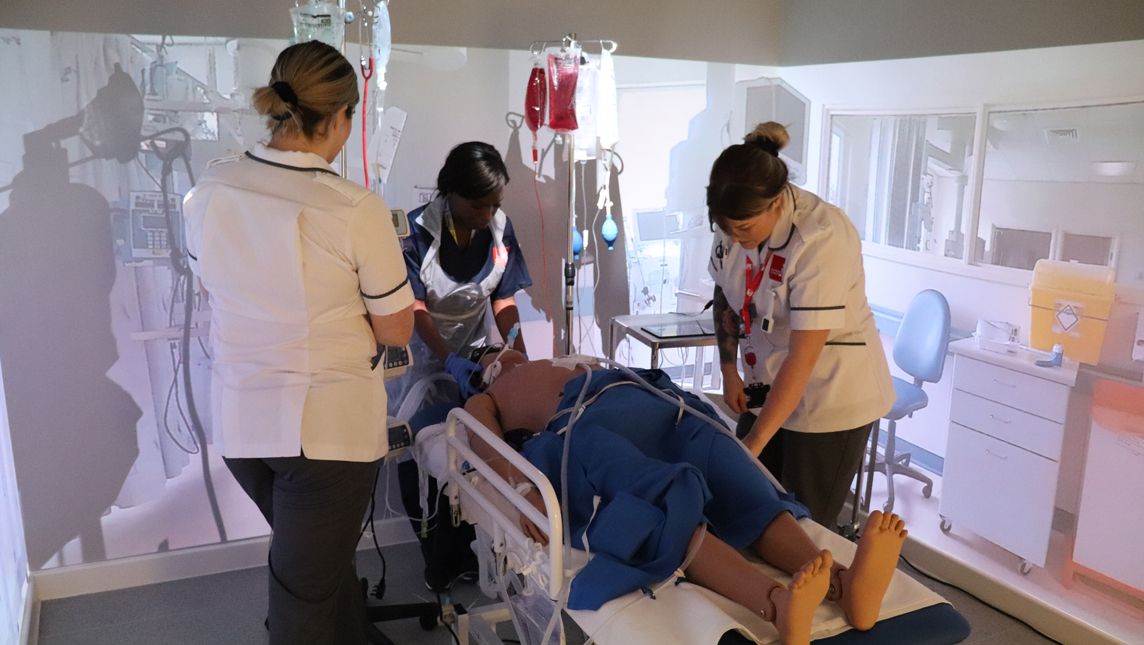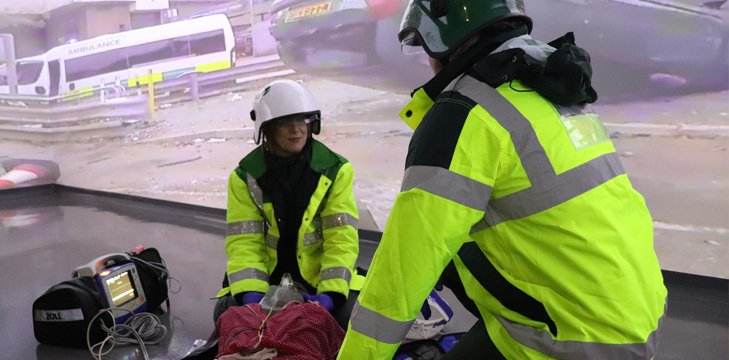
Simmersive Staffordshire: bringing together people, place and pedagogy for practising clinical skills
Imagine you’re a student nurse about to put a needle into a patient’s vein: your first ever intravenous cannula. How would you introduce yourself to the patient, allay their nerves, explain what you’re about to do, prepare the equipment and then perform the physical procedure?
It’s an everyday activity for experienced nurses but one that takes practice and confidence to accomplish well.
Healthcare students at Staffordshire University aren’t short of either practice or confidence, thanks to the university’s Centre for Health Innovation. In its range of flexible ‘simmersive’ environments – from emergency departments to maternity units, nursing bays to roadside lay-bys – student nurses, paramedics, midwives and others can hone their skills safely.
Some of the spaces are completely immersive, some use augmented reality (AR), others are simulation rooms that replicate the environments that students will experience in hospitals, clinics and even patients’ living rooms. These spaces use manikins ranging from highly interactive, life-like simulators to more traditional training manikins.

Professor Raheel Nawaz, pro vice chancellor – digital transformation at Staffordshire University, says:
“We coined the term ‘simmersive’ to highlight how cutting-edge buildings with digital in their DNA can combine with innovative digital pedagogies to make the student experience as authentic as it can possibly be.”
Exciting development
For Mike Phillips, executive dean at the School of Health, Science and Wellbeing at Staffordshire University, it’s an exciting development that’s creating a more realistic and effective learning environment for much-needed frontline workers.
He said:
“We are getting fantastic feedback from our students. They tell us they feel much more acquainted with the environments they're going into and much better prepared. These practice learning opportunities better reflect the incredibly daunting demands placed on them when they enter clinical practice, as students and ultimately as qualified healthcare professionals."
Five-stage pedagogic model
One of the keys to the programme’s success is that the simulation and immersion technology is used as part of a carefully thought-out five-stage process of incremental exposure towards real world practice.
It takes novice learners, who have little or no experience of delivering care, on a progression from keynote lectures to facilitated skills sessions then simulation sessions and debriefing – and all in a controlled environment.
Crucially, the learning is not limited to those students who can fit into the simulation space in each session. The centre uses technology to give additional learners who aren't in that scenario a better experience of seeing and hearing what's going on in the space.
As Mike Phillips explains,
“We take the live captured audiovisual footage from the simulation space and relay it live into an adjacent learning space for the rest of the cohort who can watch in real time. We prime them to be vigilant about what they're seeing and experiencing, which creates material for the peer-to-peer debrief that we facilitate at the end. That gives them a different view of what's going on in a scenario.”

Placement challenges
Staffordshire’s use of 'simmersive' technology and pedagogy in this way is an imaginative response to a key challenge facing healthcare students and their educators in recent years: finding high-quality placements at a time when demand is growing.
With 10,000 more nurses being recruited over the next five years and students required to complete 50% of their course in a practice learning environment, competition for those placements is fierce, especially when staffing capacity in the NHS is so tight.
Even the nature of the experience gained on the placements has changed – where a student paramedic may have previously experienced a range of clinical practice in every given shift, in more recent times that shift might have involved sitting with just one patient in the back of an ambulance outside an emergency department.
As a result, students are not being exposed to the same volume of clinical challenges on placement but very different ones that may require different skill sets. Experiencing a wider range of situations in a simulation environment that is vividly realistic yet safe can help students feel less unnerved when faced with them in a live setting.
Staffordshire’s move to simmersive was made easier by the creation of an entirely new building for the initiative, so that the technology could be built in from the start rather than retrofitted into existing rooms. A close partnership approach has been essential, including with other university partners, healthcare providers and the technology partner – CAE Healthcare, one of the world's leading providers of immersive and simulation-based technology.
The three Ps
However, while not every university can create a new facility from scratch, the principles underlying Staffordshire’s successful simmersive journey have a relevance to digital innovation in HE far beyond Staffordshire. Mike Phillips calls them the ‘three Ps’ – the people, the place and the pedagogy.
“These are the three legs of the stool for us with regards to our immersive journey and our simulated learning at Staffordshire University. The role that the technology plays is absolutely integral, but it would be meaningless without the other two Ps. Each must be as strong as the other.”
Culture is all
The three Ps philosophy ties into Staffordshire's wider digital transformation programme, with a revamped university strategy that is “digital at core” but heavily focused on people and culture.
According to Professor Nawaz:
"Senior leaders in higher education cannot afford to ignore culture and people. Culture eats strategy for breakfast and it will eat technology for lunch and any digital transformation strategy for dinner. Unless we involve our stakeholders, our colleagues across professional services and academy, and work very closely with students to co-create, none of our strategies are going to work.”
Watch this space
And what next for Staffordshire’s simmersive journey? Professor Nawaz highlighted that the successful implementation of the simmersive framework in clinical settings has encouraged Staffordshire to start introducing this approach within other practice-based disciplines. The university is also launching an MSc programme in simulation-based education, offering a multidisciplinary approach to developing the skills and knowledge of educators using simmersive as a pedagogic approach.
But there is also a mystery element, as Mike Phillips explains.
“We have kept one space within the new building as a grey, empty room. The challenge I have set to educators is to come back to us when they've got an idea based on something new that emerges, such as a technological development or a new pedagogic approach or technique so that we can be ready to occupy that space with something that's different and innovative. As well as a physical place it is a metaphorical platform for us to be able to work towards the next approach within this simmersive space.”
So, watch that space!
Find out more
- Hear more about Staffordshire University’s innovative work from Professor Raheel Nawaz and Mike Phillips in our Beyond the Technology podcasts: Demonstrating digital transformation at Staffordshire University and Demonstrating digital transformation - Using immersive rooms at Staffordshire University
- Staffordshire University hosted the first of our demonstrating digital transformation events – find out more about the events in this series
- Our framework for digital transformation in higher education is a comprehensive perspective on how the digital environment can support positive work, research and learning experiences, and promote a sense of belonging and wellbeing.